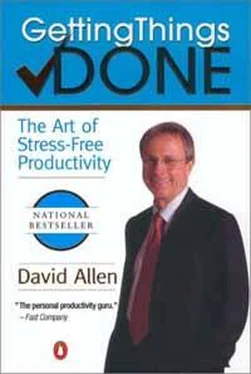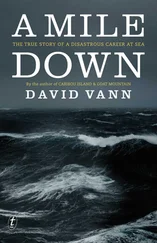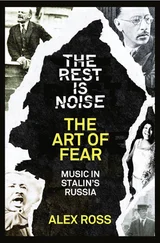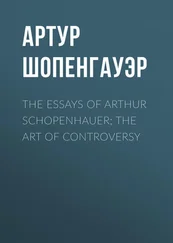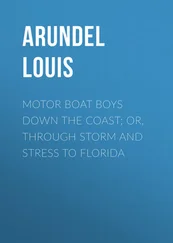The major reason for the lack of this kind of effective value-added thinking is the dearth of systems for managing the potentially infinite amount of detail that could show up as a result. This is why my approach tends to be bottom-up. If you feel out of control with your current actionable commitments, you'll resist focused planning. An unconscious pushback occurs. As you begin to apply these methods, however, you may find that they free up enormous creative and constructive thinking. If you have systems and habits ready to leverage your ideas, your productivity can expand exponentially. In chapter 3, I covered in some detail the five phases of project planning that take something from the idea stage into physical reality.
The middle of every successful project looks like a disaster.
—Rosabeth Moss
What follows is a compilation of practical tips and techniques to facilitate the natural, informal planning processes I recommend. Although these suggestions are all based on common sense, they're not followed nearly as frequently as they could be. Put them to use whenever and as often as you can, instead of saving up your thinking for big formal meetings.
You need to set up systems and tricks that get you to think about your projects and situations more frequently, more easily, and in more depth.
Which Projects Should You Be Planning?
Most of the outcomes you have identified for your "Projects" list will not need any kind of front-end planning, other than the sort you do in your head, quickly and naturally, to come up with a next action on them. The only planning needed for "Get car inspected," for example, would be to decide to check the phone book for the nearest inspection location and call and set up a time. There are two types of projects, however, that deserve at least some sort of planning activity: (1) those that still have your attention even after you've determined their next actions, and (2) those about which potentially useful ideas and supportive detail just show up.
The first type—the projects that you know have other things about them that must be decided on and organized—will need a more detailed approach than just identifying a next action. For these you'll need a more specific application of one or more of the other four phases of the natural planning model: purpose and principles, vision/outcome, brainstorming, and/or organizing.
The second type—the projects for which ideas just show up, ad hoc, on a beach or in a car or in a meeting—need to have an appropriate place into which these associated ideas can be captured. Then they can reside there for later use as needed.
Projects That Need Next Actions About Planning
There are probably a few projects you can think of right now, off the top of your head, that you know you want to get more objectified, fleshed out, and under control. Perhaps you have an important meeting coming up and you know you have to prepare an agenda and materials for it. Or you've just inherited the job of coordinating the annual associates' conference, and you've got to get it organized as soon as possible so you can start delegating significant pieces. Or you've got to clarify a job description for a new position on your team to give to Human Resources. If you haven't done it already, get a next action now that will start the planning process for each of these, and put it on the appropriate action list. Then proceed with further planning steps.
Typical Planning Steps
The most common types of planning-oriented actions will be your own brainstorming and organizing, setting up meetings, and gathering information.
Brainstorming Some of the projects that have your attention right now will require you to do your own free-form thinking; this is especially true of those for which you were not clear about what the next action would be when you made that decision. These should all have a next action, such as "Draft ideas re X."
You need to decide where and how you want to do that action, in order to know which action list to put it on. Do you do this kind of thinking best on a computer, or by hand-writing your thoughts on paper? I may choose either medium, depending on what my intuition tells me. For me this next action would go either on my "At Computer" list or on "Anywhere" (because I can draw mind-maps wherever I am, as long as I have pen and paper).
Organizing You may have some projects for which you have already collected notes and miscellaneous support materials, and you just need to sort through them and get them into a more structured form. In this case, your next action would likely be "Organize Project X notes." If you have to be in your office to do that (because that's where the files are, and you don't want to carry them around), that action should go on your "At Office" action list. If you're carrying the project notes around with you in a folder, or in a portable organizer or on a laptop, then the "Organize . . . " action would go on an "Anywhere" or "Misc." action list if you're going to do it by hand, or on "At Computer" if you're going to use a word processor, outliner, or project-planning software.
Setting Up Meetings Often, progress will be made on project thinking when you set up a meeting with the people you'd like to have involved in the brainstorming. That usually means sending an e-mail to the whole group or to an assistant to get it calendared, or making a phone call to the first person to nail down a time.
One of the greatest blocks to organizational productivity is the lack of decision by a senior person about the necessity of a meeting, and with whom, to move an important issue forward.
Gathering Information Sometimes the next task on project thinking is to gather more data. Maybe you need to talk to someone to get his or her input ("Call Bill re his thoughts on the managers' meeting"). Or you need to look through the files you just inherited from last year's conference ("Review Associate Conference archive files"). Or you want to surf the Web to get a sense of what's happening "out there" on a new topic you're exploring ("R&D search firms for sales executives").
Random Project Thinking
Don't lose any ideas about projects that could potentially be useful. Many times you'll think of something you don't want to forget when you're a place that has nothing to do with the project. You're driving to the store, for example, and you think of a great way that you might want to start off the next staff meeting. Or you're stir-ring the spaghetti sauce in the kitchen and it occurs to you that you might want to give out nice tote bags to participants in the upcoming conference. Or you're watching the evening news when you suddenly remember another key person you might want to include in the advisory council you're putting together.
If these aren't specifically next actions that can go directly on your action lists, you'll still need to capture and organize them somewhere that makes sense. Of course the most critical tools for ensuring that nothing gets lost is your collection system—your in-basket, pad, and paper (or equivalents) at work and at home, and in a portable version (an index card) while you're out and about. You need to hold all your ideas until you later decide what to do with them.
Tools and Structures That Support Project Thinking
No matter at what level project ideas show up, it's great to have good tools always close at hand for capturing them as they occur. Once they've been captured, it's useful to have access to them whenever you need to refer to them.
Thinking Tools
One of the great secrets to getting ideas and increasing your productivity is utilizing the function-follows-form phenomenon — great tools can trigger good thinking. (I've come up with some of my most productive thoughts when playing with my Palm organizer in an airport, waiting for a flight!)
Читать дальше
